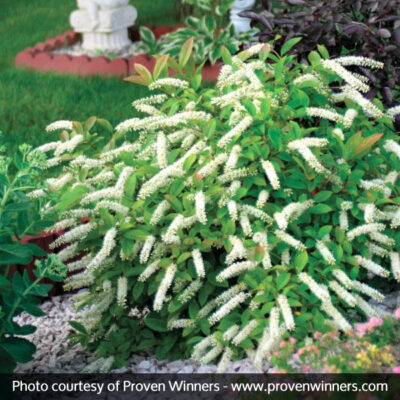Garden Plant: Little Henry Virginia Sweetspire
Product Description: Little Henry Virginia Sweetspire

Perfect Solution Little Henry Virginia Sweetspire
- Use in Sun to Full Shade
- Fragrant, Showy Blooms in Early Summer
- Bottlebrush White Flowers Cover these Compact Shrubs
- Amazing Fall Color
- Great for Containers or Shrub Borders
- Tough Little Plant Handles Both Drought and Works in Wet Soil
- Tolerates Sun or Shade
- Deer Tend to Leave it Alone
Need a hard-working, beautiful native deciduous shrub to polish your landscape? Rely on Little Henry Virginia Sweetspire (Itea virginica \’Sprich’) to really boost the visual appeal.
This dwarf ornamental shrub features fabulous early summer flowers and leaves that turn vivid oranges and reds in the fall. You’ll also love it’s easy-care nature!
This improved Proven Winners cultivar stays smaller and more compact than the native species and other varieties. It is also truly adaptive to a variety of growing conditions.
Durable, cute Little Henry Sweetspire grows beautifully in full sun, partial sun or full shade. It can grow in both boggy ground, but can also handle periodic drought.
Let it delight you and your guests with its fireworks profusion of whimsical blooms in early summer. Your local butterflies and hummingbirds will also adore the 6-inch long, sweetly drooping racemes of fragrant flowers.
All summer, the mounded, tidy form of Little Henry will work hard as a pretty edging plant. You’ll want to give them a prime spot front and center, so you can enjoy watching the vibrant green foliage put on their flaming fall color display.
These native plants deliver as impactful a fall display as Burning Bush! You’ll be rewarded with a riotous harvest color mix in the fall to close out your season.
Overall, it’s generally a trouble-free, ornamental shrub. Little Henry Sweetspire will live 40 years or more.
Place your order for Little Henry Virginia Sweetspire. Our growers love it, and it’s sure to become one of your special favorites, too.
How to Use Little Henry Virginia Sweetspire in the Landscape
This versatile charmer can be used in just about any sun or soil condition. Why not take advantage of this rare trait?
Use this as a long-running low edging hedge through sunny and shade conditions in many parts of your yard. Or, tie your landscape together by repeating its use throughout your garden beds.
Little Henry is great for grouping and for massing on large banks to control erosion. Plant two feet apart on center in staggered, zigzagging rows.
They’ll grow together to create a solid planting. Measure from the center of one to the center of the next, and be sure to keep new mass plantings weeded while they fill in.
Brighten up a side yard, include in a Butterfly Garden or try them as a “Thriller” in containers placed on either side of your front door. They look wonderful running along the path of woodland gardens.
It prefers moist soils and will tolerate wet conditions. They make great additions to Rain Gardens.
This is also a wonderful plant for the front of the mixed shrub border. Its small size makes it perfect for smaller borders and beds. They’ll also be helpful as facer plants at the base of “leggy” larger shrubs.
Include several Little Henry’s near your vegetable garden or fruit trees. They will perform beautifully to entice pollinators for a plentiful harvest.
Pro Plant Tips for Care
Give them a planting spot in full sun to full shade. The more sun they receive, the more blooms they’ll produce. As well, more sun delivers a better fall color display.
They grow in both moist, wet areas and in well-drained soil conditions. Once established, can tolerate dry conditions.
We do recommend that you give it a moderate amount of water for best results. Be sure to water your Sweetspire well in late fall, as you head into winter.
If you would like, prune them after they bloom. If you notice any winter damage after a harsh winter, prune it out soon after new growth has begun.
Fertilize in early spring with a good, organic, slow-release fertilizer. Use the application rate listed on the label.
Little Henry is a useful native plant with lots of potential for the home landscape. Order now!


